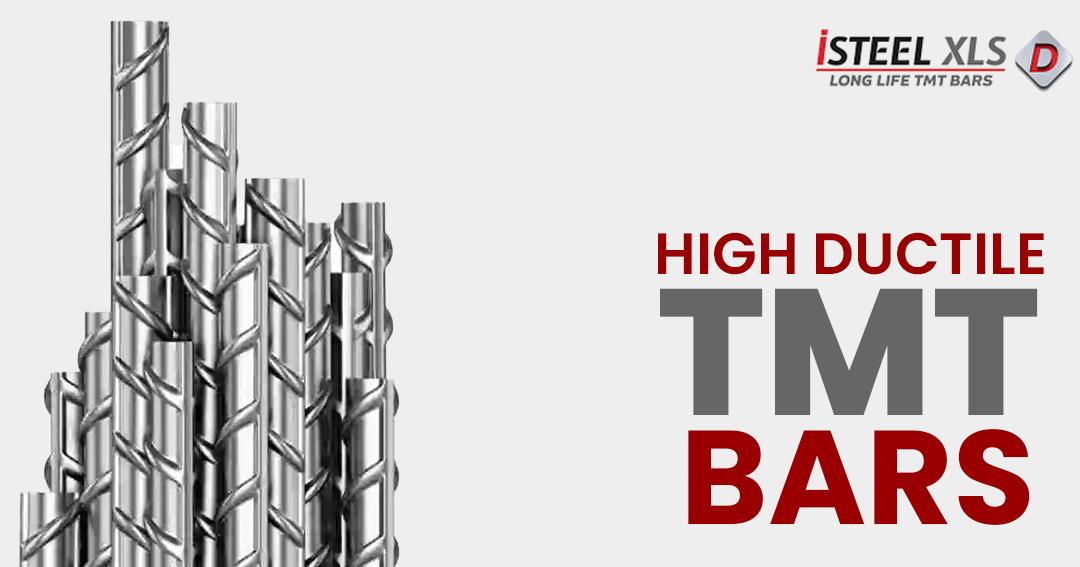Enhancing Performance: The Evolution of High Ductile TMT Bars

- By : admin
- 0 Comments
The evolution of materials plays a crucial role in shaping the landscape of building design, durability, and safety. High Ductile Thermo-Mechanically Treated (TMT) bars have emerged as a game-changer in the construction industry, offering enhanced performance and structural integrity. In this blog post, we’ll explore the journey of high ductile TMT bars, from their inception to the present, and delve into the factors driving their evolution.
High ductile TMT bars are gaining traction in seismic-prone regions, where structural resilience is paramount. The Indian construction industry is witnessing a shift towards high ductile TMT bar due to their superior strength, ductility, and corrosion resistance.
Evolution of High Ductile TMT Bars:
1. Introduction of Thermo-Mechanical Treatment (TMT) Technology:
The evolution of high ductile TMT bar began with the introduction of thermo-mechanical treatment technology. This innovative process involves subjecting the steel bars to controlled heating and rapid cooling, imparting them with superior mechanical properties and enhanced ductility.
2. Enhanced Ductility and Flexibility:
Unlike conventional steel bars, high ductile TMT bar undergo a unique manufacturing process that refines their microstructure, resulting in improved ductility and flexibility. This allows the bars to withstand dynamic loads and seismic forces, reducing the risk of structural failure during earthquakes or other natural disasters.
3. Corrosion Resistance:
Another key aspect of the evolution of high ductile TMT bar is their enhanced corrosion resistance. By incorporating corrosion-resistant elements such as chromium and copper into the steel alloy, manufacturers can prolong the lifespan of TMT bars and ensure long-term structural integrity, particularly in coastal or humid environments.
4. Advanced Testing and Quality Control:
With advancements in testing methodologies and quality control processes, manufacturers can ensure the consistency and reliability of high ductile TMT bar. Rigorous testing protocols, including tensile strength tests, bend tests, and spectroscopic analysis, enable manufacturers to deliver TMT bars that meet stringent performance standards.
5. Sustainability and Environmental Considerations:
As sustainability becomes increasingly important in the construction industry, the evolution of high ductile TMT bars also encompasses environmental considerations. Manufacturers are adopting eco-friendly practices such as recycling scrap steel and reducing energy consumption in the production process, aligning with global sustainability goals.
6. Innovation in Design and Engineering:
The evolution of high ductile TMT bar extends beyond material properties to encompass innovative designs and engineering solutions. From ribbed surface patterns for enhanced bond strength to specialized coatings for improved corrosion resistance, manufacturers are continuously innovating to meet the evolving needs of the construction industry.
7. Adoption of International Standards:
With the globalization of the construction industry, the adoption of international standards and certifications has become crucial for high ductile TMT bar. Compliance with standards such as ASTM, BS, and IS ensures interoperability, quality assurance, and compatibility with global construction practices.
8. Application in Seismic-Resistant Construction:
High ductile TMT bars are increasingly being utilized in seismic-resistant construction projects, where structural resilience is of utmost importance. Their superior ductility and strength-to-weight ratio make them ideal for reinforcing buildings and infrastructure in earthquake-prone regions, reducing the risk of catastrophic damage.
9. Advantages in Construction Practices:
High ductile TMT bar offer several advantages over traditional steel reinforcement in construction practices. Their enhanced ductility allows for easier bending and shaping during fabrication, reducing labor costs and construction time. Additionally, their superior strength-to-weight ratio enables the construction of lighter and more efficient structures, minimizing material usage and environmental impact.
10. Cost-effectiveness:
While high ductile TMT bars may have a higher initial cost compared to conventional steel bars, their long-term benefits often outweigh the upfront investment. The enhanced durability and corrosion resistance of high ductile TMT bar results in lower maintenance costs over the lifespan of a structure. Moreover, their superior performance in seismic-prone areas can lead to significant savings by reducing the risk of structural damage and downtime.
11. Regulatory Compliance:
The evolution of high ductile TMT bars has been driven, in part, by stringent regulatory requirements for construction materials. These bars comply with national and international standards for structural reinforcement, ensuring adherence to building codes and regulations. By using high ductile TMT bar that meet regulatory standards, construction projects can mitigate risks and liabilities associated with non-compliance.
12. Future Trends and Innovations:
Looking ahead, the evolution of high ductile TMT bars is expected to continue with ongoing research and development efforts aimed at further enhancing their performance and sustainability. Future innovations may include the integration of advanced materials, such as carbon nanotubes or graphene, to further improve strength and durability. Additionally, advancements in digital technologies, such as artificial intelligence and predictive analytics, may enable real-time monitoring of structural health and performance, optimizing maintenance and lifecycle management strategies.
The evolution of high ductile TMT bars represents a paradigm shift in the construction industry, offering unprecedented levels of performance, durability, and safety. From advancements in manufacturing technology to innovations in design and engineering, high ductile TMT bar continue to redefine the standards of structural reinforcement. As the demand for resilient and sustainable construction materials grows, high ductile TMT bar are poised to play a central role in shaping the future of building design and infrastructure development worldwide.
